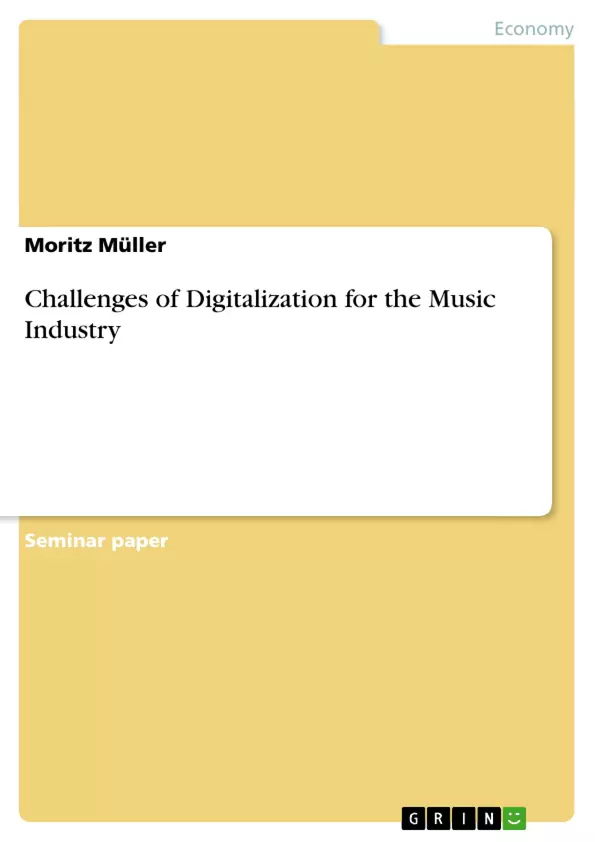This seminar paper analyses how the digitalization has changed the general set-up of the music industry. By analyzing studies and data, the paper illustrates several challenges that influenced record sales. Considering the different type of players in the music industry - record labels, online and physical retailers, and artists - this paper will only discuss the challenges and effects of the digitalization on the major record labels. The challenges of digitalization for artists will not be covered in this paper; digital music actually enhances the chance of being discovered and for reaching a larger audience (Ankeny 2012). In this sense, the digitalization is an opportunity, rather than a challenge for artists. This also applies for online retailers such as iTunes and Amazon. Since digital music does not require physical storage, online retailers can offer music at almost zero costs. Thus, online retailers benefit from the digitalization of music. Physical retailers presumably lose revenue because of the digitalization of music. However, their situation will not be discussed further, in this paper. The major record labels are highly vertically integrated (Neff and Blömer 2003, p. 104). Besides managing artists, the recording companies are also in charge of the publishing and copyrights of music. Additionally, they have enormous production resources and strong distribution networks. This gives the major record labels a significant competitive advantage. However, this advantage was partly ruined by the digitalization. In this paper, digitalization of the music industry is limited to the impact of MP3s on the industry. The introduction of the CD as the first phase of digitalization is not further discussed. Chapter two deals with the challenge of piracy for the record companies. In chapter three, the increased competition as a challenge will be described. The change of the product music is discussed in chapter four. Chapter five presents the changing con-sumer behavior, as the final challenge for the major record labels. Every chapter is concluded by presenting the reactions of the record labels to the respective chal-lenges. The paper is rounded off by a conclusion, in which the main points are sum-marized and a discussion of future strategies for the record labels.
Inhaltsverzeichnis (Table of Contents)
- 1 Introduction
- 2 Piracy
- 2.1 The Effect on Record Sales
- 2.2 Reactions to Piracy
- 3 Increased competition
- 3.1 Lower Barrier to Entry
- 3.2 Independent Labels Gain Importance
- 3.3 Annulling the Record Labels
- 3.4 Reactions to Increased Competition
- 4 Change of the Product Music
- 4.1 With the MP3 Came the Cherry-Picking
- 4.2 Lower Prices and Willingness to Pay for Digital Music
- 4.3 Reactions to Change of the Product Music
- 5 Change in Consumer Behavior
- 5.1 Profile of Music Consumers
- 5.2 More Digital less Physical
- 5.3 Reactions to Change in Consumer Behavior
- 6 Conclusion
- 7 Future Strategies
- 7.1 Piracy
- 7.2 Increased Competition
- 7.3 Change of Product Music
- 7.4 Change in Consumer Behavior
Zielsetzung und Themenschwerpunkte (Objectives and Key Themes)
This seminar paper explores the impact of digitalization on the music industry, focusing on the challenges faced by major record labels. It aims to analyze how digital technologies have altered the production, distribution, and consumption of music, and the resulting effects on record sales.
- Piracy's impact on record sales and industry responses
- Increased competition from digital platforms and independent labels
- The shift from physical to digital music formats and its implications
- Changes in consumer behavior and the rise of digital music consumption
- Future strategies for record labels in a digitalized music industry
Zusammenfassung der Kapitel (Chapter Summaries)
The introduction lays the groundwork for the paper, establishing the concept of digitalization and its transformative effect on the music industry. It highlights the decline in record sales and the emergence of new digital players, setting the stage for exploring the challenges faced by major labels.
Chapter 2 delves into the issue of piracy, examining its impact on record sales and the industry's responses to combat it.
Chapter 3 investigates the heightened competition in the music industry brought about by digitalization. It analyzes the lower barrier to entry, the increasing prominence of independent labels, and the challenge posed by digital platforms to major labels.
Chapter 4 focuses on the change in the product "music" itself. It explores the shift to digital formats, particularly the MP3 format, and its implications for record labels, including cherry-picking of individual tracks and the need to adjust pricing strategies.
Chapter 5 examines the evolving consumer behavior, highlighting the increasing preference for digital music consumption and the changing profile of music consumers.
While the paper concludes with a chapter outlining future strategies for record labels in a digitalized music industry, this summary omits details from this final chapter to avoid spoilers.
Schlüsselwörter (Keywords)
This seminar paper focuses on key themes and concepts within the music industry. The primary topics include digitalization, piracy, increased competition, change in product music, change in consumer behavior, and record labels. The study explores the impact of these factors on the industry, analyzing the challenges and opportunities they present for major labels in a digitalized world.
- Citation du texte
- Moritz Müller (Auteur), 2013, Challenges of Digitalization for the Music Industry, Munich, GRIN Verlag, https://www.grin.com/document/231543



